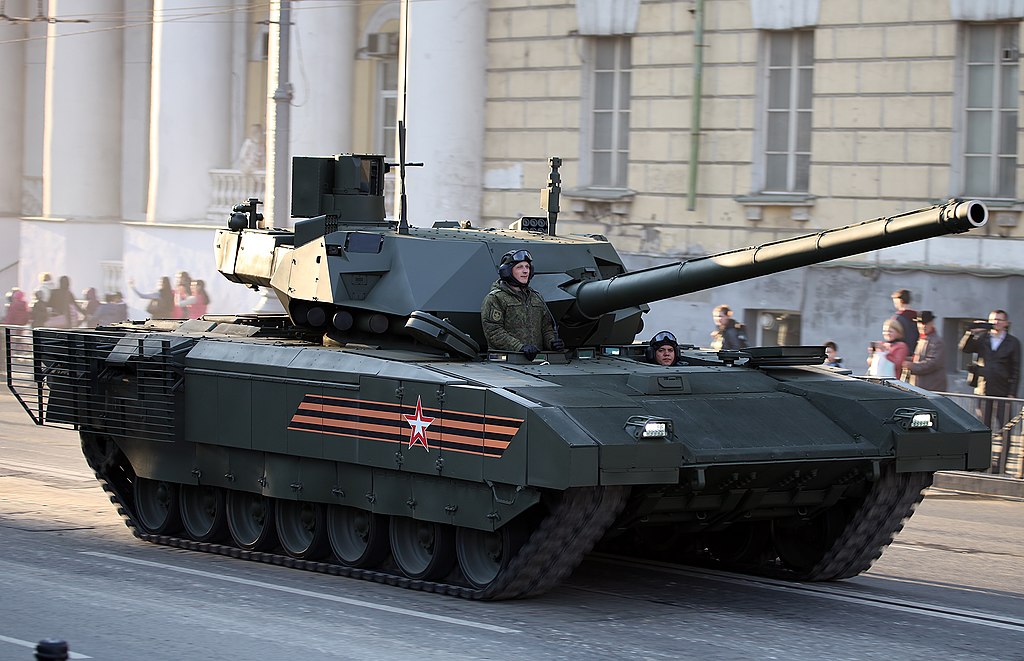T-14 Armata
The T-14 Armata (Russian: Т-14 «Армата»; industrial designation "Ob'yekt 148", Russian: Объект 148) is a next-generation Russian main battle tank prototype based on the Armata Universal Combat Platform. It has not yet entered serial production or been deployed with any units.
The Russian Army initially planned to acquire 2,300 T-14s between 2015 and 2020. By 2018, production and fiscal shortfalls delayed this to 2025, before Russia announced the apparent cancellation of the main production run on July 30th, 2018. However, as of 2021, Russian state-owned TASS media agency claimed the Armata had been expected to begin serial production in 2022, with delivery of a test batch of 100 to the 2nd Guards Tamanskaya Motor Rifle Division expected to begin in 2022. No evidence of this has yet emerged. The tanks were planned to only be officially transferred following completion of all state tests.
Design[edit source]
The Armata was designed over the course of five years, and features a number of innovative characteristics, including an unmanned turret. The crew of three is seated in an armoured capsule in the front of the hull, which will also include a toilet for the crew.
Armament
The Vacuum-1 APFSDS round, developed for the 2A82-1M gun, has a penetrator that is 900 mm long,[1] and is said to be capable of penetrating 1000 mm of RHA equivalent at a distance of 2 km. The new controlled-detonation Teknik HE-Frag shell is available and has entered service. The gun is capable of firing guided missiles like the 9M119M1 Invar-M which has an effective range of 100 m to 5 km, and can engage low-flying air targets such as helicopters, with a new 3UBK21 Sprinter ATGM with an effective range up to 12 km developed specifically for it. 3UBK25 active homing ATGM is currently under development.
The secondary armament consists of a 12.7×108mm Kord (GRAU index 6P49) machine gun with 300 rounds (not observed during the 2015 parade) and a 7.62×54mmR Pecheneg PKP (GRAU Index: 6P41) or a PKTM (6P7К) machine gun with 1,000 rounds. All guns are remotely controlled. In addition, another 1,000 rounds can be stored separately.
The cannon, which was first developed in 2000 for the T-95 prototype, has a high-speed APFSDS shell with a 1,980 m/s muzzle velocity, only dropping to 1,900 m/s at 2 km. However, Russian engineers have so far kept the 125 mm-size gun, assessing that improvements in ammunition are enough to increase effectiveness, while concluding that a larger bore weapon would offer few practical advantages.
The T-14 can also use anti-aircraft missiles. A 30 mm anti-aircraft gun may be installed in the near future.
Mobility
During the protoype stage, several engines with power outputs ranging from 1500 to 2000 hp were tested on the platform, with the 1500 hp version reportedly allowing a max speed of 82 km/h. The T-14 is powered by a ChTZ 12N360 (A-85-3A) diesel engine delivering up to 1,100 kW (1,500 hp). The engine's theoretical maximum power, not normally used, is 1,500 kW (2,000 hp), at the cost of radically decreasing its service life, projected min 2,000 hours at a nominal 1,100 kW (1,500 hp), comparable to other modern tank engines, and up to 10,000 hours at a moderated 890 kW (1,200 hp). The engine is electronically controlled. Operational range is over 500 km.
The T-14 has a 12-speed automatic gearbox, with a top speed of 80–90 km/h (50–56 mph) and a range of 500 km (300 mi). Other sources suggest a partly or fully hydrostatic transmission.
Unlike previous Russian and Soviet designs, such as the T-90/80/72/64, the T-14 has seven 700 mm road wheels per side, based on the T-80 variant. This may have been done to improve the pivoting ability of the tank, as an active suspension system improves the target lock time by a factor of 2.2, and reduces the timeframe between target detection and reaction by 31%, all due to the resulting smoother ride.
copied by wikipedia.

Comments
Post a Comment